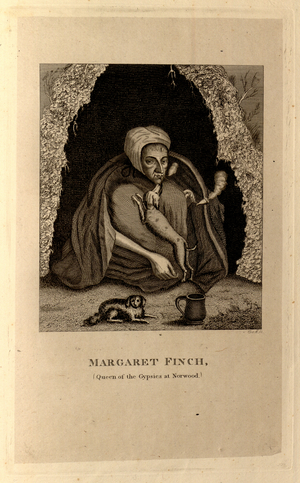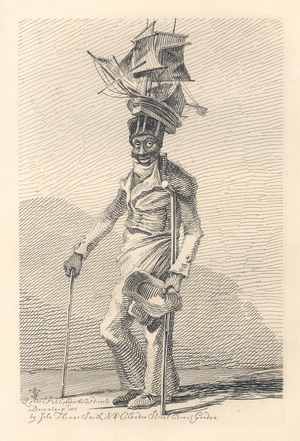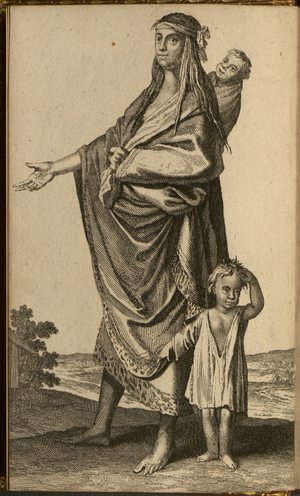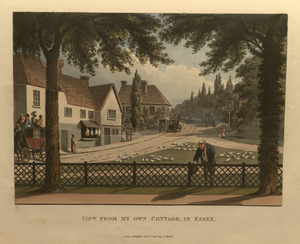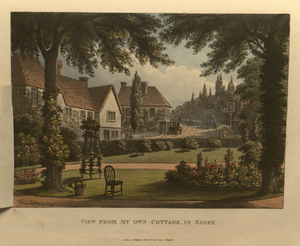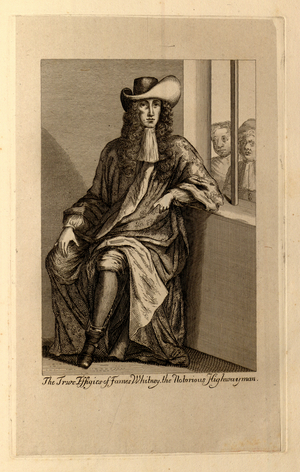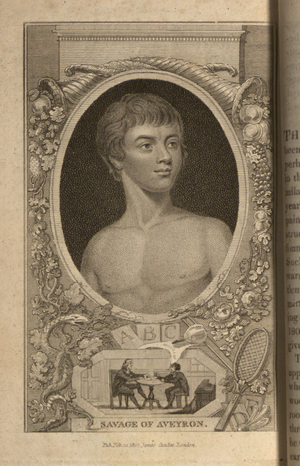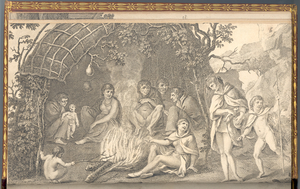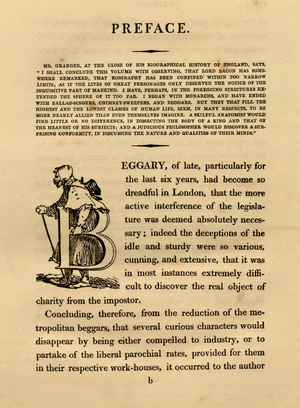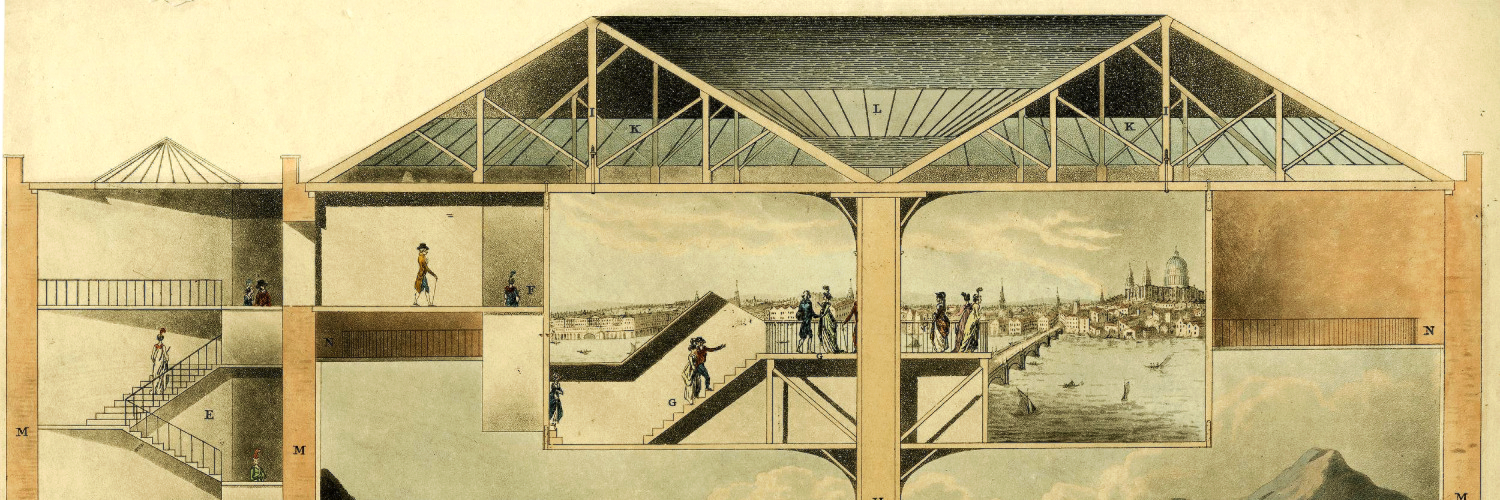‘“[. . .] their movement cannot be captured in a picture, nor can the meaning of their movements be circumscribed in a text”
’
Epitomized by Caspar David Friedrich’s Wanderer Watching a Sea of Fog (c. 1817-18), and the Wordsworthian peripatetic, the gentlemanly or artistic wanderer is integral to the Romantic imagination. Wandering lies at the heart of picturesque sightseeing, blank verse poetry, specimen collecting, and the Romantic cultivation of self. However, these forms of sanctioned wandering exist against a backdrop of less desirable movements that, nonetheless, inform, color, and at times literally converge with, the endorsed amblings of the inquisitive artist-gentlemen. Unsanctioned forms of wandering existed on a spectrum of criminality, which at times included peddlers, actors, shepherds, discharged soldiers, beggars, orphaned children, gypsies, sailors, highwaymen, pirates, and ultimately, as Toby Benis has argued, “anyone on the road without adequate cause” (2). These disparate groups, while often meticulously differentiated, were also increasingly amalgamated as vagrants through a series of common burdens and discriminatory practices, resulting from changing Poor Laws, licensing, and Vagrancy Acts in the eighteenth and early nineteenth centuries.
It is not my aim or desire to reproduce here an exhaustive catalog of wandering types. Rather, I hope to sketch some of the strategies of representation used to capture the vagrant body in print. And further, to tease out some of the tensions and slippages between the text as material object and the roaming body it seeks to arrest. To do this I will examine a selection of British Romantic prints, all bound in books published in London in the first two decades of the nineteenth century (1800-1820). Some of these texts explore a signal category of wanderer (e.g., the urban beggar in the case of John Thomas Smith’s Vagabondiana, or, Anecdotes of mendicant wanderers through the streets of London [London, 1817], or the gypsy in the case of Heinrich Moritz Gottlieb Grellmann’s Dissertation on the Gipseys [London, 1807]) while others assemble a variety of eccentric persons, among which can be found wandering types (e.g., James Caulfield’s Portraits, Memories, and Characters, of Remarkable Persons [London, 1819], or G.H. Wilson’s The Eccentric Mirror [London, 1806]). The prints discussed are chosen because they represent different strategies of resistance to the project of containment or arrest, strategies which include signifying in ways that resist the cataloging missions of the text/author, critiquing the text as material object and commodity, representing stasis as a potentially political act, and encouraging the reader/viewer to be cognizant of their complicity in processes of erasure.
The rich body of scholarship interested in Romantic vagrancy tends to focus primarily on Wordsworth’s representation of and engagement with the itinerant poor. The hope of this project is to explore how a more sustained survey of contemporaneous visual representations might alter and expand our understanding of Romantic vagrancy and its relationship both to the artist’s construction of self and the (supposedly) static image. This project resists the impulse to treat as a given the print’s stasis, or to accept prints as a default medium used in the absence of alternative representational technologies. In highlighting the tension of wandering as a space-time practice and the apparent stasis of the published print, I do not mean to suggest that Romantic moving-picture technologies (such as P.J. de Loutherbourg’s Eidophusikon, exhibited in London in 1781) would have offered a more accurate, neutral, or appropriate means of representing acts of unsanctioned wandering. Rather, by examining prints that represent wanderers we are able to explore instances of resistance that complicate a binary understanding of the moving and the still. Prints may seem to “arrest” or “make still” the wandering impulse, but they also reproduce and disseminate the vagrant body. In this way, prints allow for the movement of images even if they are not typically considered “moving images.”
The Romantic era saw the displacement of many people as a result of enclosure, clearances, and revolutions. As Anne Wallace has argued, the resultant increase in pedestrian mobility, not only in the form of those exiled from common lands and sent adrift, but also in the form of “deliberate excursive walking, especially by the relatively well-to-do and educated,” meant increased contact between those wandering for spiritual or artistic refinement and those made mobile out of economic necessity (166). Such contacts feature prominently in the poetry and prose of the Romantic period, as authorial wanderers frequently encounter members of the wandering class, finding cause to celebrate, condemn, or identify with those traversing the landscape in less orthodox ways.
While it may be problematic to assemble such divergent groups into a single category, a series of late eighteenth- and early nineteenth-century laws and ordinances worked to consolidate the wandering poor and to place them in a particular relationship to a wage- and settlement-based economy, which, I would argue, gave them a distinct class status. Since 1662, poor relief had been largely based on a system of parish charity that took “settlement” (defined as birth, long-term residence, or employment in a given community) as a prerequisite for assistance (22-23, 29). The wandering poor were inherently disqualified from such assistance, as they were not settled and were thus not the responsibility of any particular parish. Furthermore, this system of localized assistance increased hostilities towards the unsettled, as those forced to pay the poor rate were invested in limiting any additional burden on parish funds. Tales of transporting pregnant women in labor over parish lines, the destruction of cottages, and the forced eviction of unwanted dependents suggest (with possible hyperbole) some of the strategies used to decrease the pauper population and its concomitant costs (Lloyd 122; Olsen 23). For the nomadic poor this meant continually enforced movement. Unwilling to take on additional charity cases, many communities set laws restricting the number of days vagrants could camp within parish limits. Simultaneously, a series of Vagrant Laws made the very act of continuous, unsettled movement a criminal offense. Thus, an ironic and illogical system was produced whereby nomadic persons were (through local ordinances) required to move regularly, yet by conforming to these laws they subjected themselves to a variety of state-sanctioned punishments, including whipping, imprisonment, and forced labor (Mayall 258).
If, as Celeste Langan has argued, vagrancy functions as both the paradigm of Romantic movement and thought, and as the structural analogy by which we understand the liberal subject, how does this liberalism relate to the materiality of the book, particularly the encyclopedic volumes of types which both contain and mimic the movements of their subjects (Langan 27)? While wandering may be integral to Romantic thought and action, so too is the desire to capture, record, and classify. Indeed, the most immediately apparent discontinuity in prints of wandering types centers on the tension between mobility and stasis. These are persons defined by their unauthorized movement, and yet, to record them as distinct personalities or types requires a degree of arrest. Thus, we find a collection of images organized around a verb that is largely unrepresented. These figures sit, stand, crouch, pose, gesture, and occasionally step, but they do not seem to wander.
A print of Margaret Finch, “Queen of the Gypsies at Norwood,” from James Caulfield’s Portraits, Memories, and Characters, of Remarkable Persons is particularly striking in its apparent stasis (figure 1). As “Queen of the Gypsies,” Finch is unequivocally a representative of a wandering people, and we are told that she has spent her life “traversing the whole of England, in the double capacity of gipsy and thief.” However, in this image we find Finch boulder-like in her squat immobility and groundedness. Having adopted the custom “of sitting on the ground with her chin resting on her knees,” the author explains, Finch’s sinews became “so contracted, that she could not extend herself or change her position” (Caulfield, Portraits, 247-249). In this way, Finch becomes almost hyperbolically immobile, her body calcifying into a stationary lump. Thus fixed, she becomes a site of pilgrimage, a cause for wandering rather than its practitioner, as “persons from the highest rank and quality to that of the lowest class in life” clog the roads leading to Norwood, hoping to see the “singularity of her figure” and benefit from the “fame of her fortune-telling” (Caulfield, Portraits, 247-249). Her spatial movement restricted, she remains an embodiment of temporal roving, as she is believed to possess the ability to see into the future.
As Michael Kramp has argued, the figure of the deformed and repulsive gypsy hag was a Romantic type constructed to undercut the “threat to heterosexual and labor (re)production” posed by the late eighteenth-century trope of Gypsy femininity as aggressively sexual. The old fortune-teller, the “antithesis of sexual allure,” does not endanger heteronormativity, or pose the threat of miscegenation (Kramp, Reconceptualization, 1339). In her decrepit and static state, Margaret Finch becomes an attraction rather than an attractor, and yet, this depiction also exceeds its presumed project to simply re-present a “type”.
Though unwanted by Norwood (Caufield complains that Surry and Kent are especially “pestered” and “plundered” by gypsies), Margaret Finch appears defiant in her stasis (Caulfield 247-249). The cave-like structure that she inhabits seems to have grown up around her, mimicking her contours and naturalizing her place in the landscape. Her face, the nose of which has been drawn in more dramatic profile than the eyes and mouth, seems to hover between a frontal and side view, and concomitantly between a specific likeness and an attempt at physiognomic typing. Her direct stare confronts the viewer, even as her pronouncedly arched and elongated nose distracts from the specificity of this address by calling upon ethnic stereotypes meant to signal her eastern origins and status as “domestic other” (Nord 5).
Bolstering the potential defiance of this address are details that would signal her irreverence to the Romantic reader. In addition to the predictable advice regarding hard work, religious devotion, and frugality, the poor were often advised to avoid unnecessary dependents, such as pets. In a 1795 article in The Times, we find a curious preoccupation with dogs as signifiers of excess (qtd. in Olsen 21-22). Dogs are presented as luxuries that may be afforded the rich, but are so impractical for the poor that their retention disqualifies their owners from charitable assistance. The presence of not just one, but two dogs solidifies Finch’s status as undeserving of—even defiant toward—charitable aid. Likewise signaling Finch’s “excess” are her tobacco pipe and drink.
Though Margaret Finch dies in 1740, anchored to a Norwood hovel by a decrepit body, through the reproduction and dissemination of this print, she regains a measure of spatial and temporal movement, persisting through time and “traversing the whole of England” once again. Here, the print seems not to “arrest” or “capture” the subject so much as record an act of defiant immobility—stasis as a political act, in the face of discriminatory laws and practices. The boulder-like solidity of Finch’s form, enveloped by the landscape and seemingly immovable, suggests an insubordinate persistence.
Refusing a teleological and hierarchicalizing narrative, recent scholarship purposes a greater degree of ambiguity, reciprocity, and oscillation between still and moving images. More importantly, such work critically rethinks the implications of stasis. Resisting an easy alignment of stasis with death, or a confusion of “rigor with rigor mortis,” Karen Beckman and Jean Ma advocate the “recursive temporality of the ‘still moving’ ” (5, 11). Beckman and Ma are particularly concerned with the political potential of the recursive and hope that it may provide an alternative to conceptualizing collective political agency solely in terms of “movement” (14). Attempting to forge a model of productive recursive activity, recent scholarship stresses the double meaning of “still,” which may be used to connote an arrest or immobility as well as a persistence or continuation. Significantly, if taken in the latter sense, “the still is on the side of becoming and moving rather than in strict opposition with it” (Kaplan 221). It is this tension or doubleness within “the still” that Jean-Luc Nancy has explored in relation to the logic of concealment (31-47). In a like vein, Jean Baudrillard has interrogated stasis that is not static in diverse instances of “freezing,” arguing that such “immobility is not an inertia, but a paroxysm which boils movement down into its opposite” (67). Whereas Nancy purposes a understanding of (the) “still” which is implicated in movement, Baudrillard insists that even if the still is understood as the antithesis of movement, it cannot be carelessly aligned with inaction or apathy. Rather, it is a particularly concentrated, dense, or “intense” extraction of that movement.
An inaugural plate in Heinrich Moritz Gottlieb Grellmann’s Dissertation on the Gipseys (figure 2), may offer an instance of one such dense freeze. Arrested in the moment of taking a step, a gypsy woman of elongated stature moves from light to shade with an infant and small child. The varied positions of eyes and bodies gives the figure group a varied directionality that seems to work against the suggestion of movement in a particular direction. At the same time, the woman’s movement from light to dark within the hillside scene suggests a true spatial movement through a landscape that is more than a token backdrop. In combination, these aspects of composition and lighting give the scene the odd effect of appearing both spontaneous and posed. A coin in the woman’s outstretched hand (though vaguely delineated) is marked by the simple cross-and-dot pattern of a medieval two- or four-pence (Fleetwood 34-35).
Though ostensibly meant to signal that the woman has received alms, this numismatic anachronism also complicates the temporality of the scene. In conjunction with the figures’ ahistorical dress, the coin suggests a temporal as well as spatial unrootedness, which stands in tension with the print’s claim to have captured a specific moment. In this way, the print seems to present its subjects as simultaneously caught in the act of wandering and performing the act with choreographed exaggeration, and thus gives us a particularly dense extraction of the act that is both specific and symbolic. While acknowledging that anachronistic details fit comfortably with primitivizing constructions of Gypsies as unchanging and timeless, we can still recognize a resistant potential between the supposed temporality of the ethnographic sketch (the claim to have captured) and suggestions of a deeper, un-moored time within the image.
The ethnographic project of containment and classification may be further undermined by the book as material object. Many of the books dedicated to vagabonds, gypsies, and others of the wandering class become themselves strangely nomadic texts. Even a work as seemingly focused as Grellmann’s Dissertation on the Gipseys is notably sprawling and fragmented in its execution. Illustrations are clearly appropriated from other contexts, and gesture more towards their disparate origins than a cohesive narrative. Even the frontispiece, an engraving of a pirate and wanderer by James Heath (1757-1834), apparently after a painting by Richard Corbould (1757-1831) or one of his sons (figure 3),
seems to have been appropriated from another context (as the unrelated volume and page numbers below the caption suggest). Thus, an image intended to introduce a focused treatise on a single topic (gypsies), instead conflates gypsies with other wandering types (pirates) and encourages the viewer to think of other mediums and published contexts for the image at hand. Unfolding pages cut to different sizes, interspersed with plates illustrating themes only tangentially related to the argument of the text, continually push the reader out of the confines of the book to imagine additional sources, narratives, and paths of inquiry. While Grellmann’s text strives to categorize, re-present, and define gypsies in a systematic fashion, its format and diverse content continually undermine this agenda.
Even in seemingly more cohesive ethnographic projects, competing desires to generalize and particularize stand in tension. In Vagabondiana, or, Anecdotes of mendicant wanderers through the streets of London, John Thomas Smith strives to depict the “wanderers” of London, but in order to obtain portraits “drawn from life” he must arrest his roaming subjects. Thus, a vagrant like “Black Joe” (Joseph Johnson) (figure 4) is identified by the specific address of his supposed encounter with Smith, “N4 Chandos Street, Convent Garden.” Ironically, however, this specific location is not articulated in the print, the background of which consists only of non-descript shading. Smith undertakes the seemingly contradictory task of assembling subjects that are both unique and representative. Organized around abstract qualities such as “industriousness,” the text produces as archive of distinct “types” valued for their perceived role as representatives of larger categories. “Black Joe” is taken to represent both the black urban poor (he is one of only two characters in the book identified by a racial signifier) and the particularly creative or ingenious beggar. Thus, Johnson is represented as both a unique subject and a type, and as both emplaced and de-contextualized.
Smith explains that Johnson, imaged with a crutch and cane, has sustained wounds rendering “him incapable of doing further duty on the ocean.” However, as a “consequence of his having been employed in the merchant’s service only,” Johnson is “not entitled to the provision of Greenwich,” and “having no claim to relief in any parish” must glean a living on the streets. Though the elaborate model ship, which Johnson wears affixed to a simple cylindrical cap, is described by Smith simply as evidence of especially creative beggary inspired by his former life as a sailor, between text and image other narratives surface. The author explains that Johnson animates his model ship “by a bow of thanks, or a supplicating inclination to a drawing room window,” thus simulating the “appearance of sea-motion” (33). Johnson’s decision to masquerade as an aquatic vessel may stem from his time as a sailor (one of many, primarily lower-class, occupations available to black Britons in the late eighteenth and early nineteenth century), and yet the juxtaposition of a black man and large ship during a time of heated debate surrounding slavery also resonates on other levels.
At the time of this sketch, the British slave trade had (ostensibly) been abolished, but slavery itself was still rampant. Additionally, ships held the threat of deportation, as London officials concocted solutions to the “problem” of the city’s black poor, an effort that culminated in an attempt to ship London’s impoverished blacks to a colony in Sierra Leone (Gerzina 142-173). Though unexplored by Smith, the context of the trans-Atlantic slave trade and the possible threat of deportation are difficult to repress. Although we are assured that Johnson’s gestures are “supplicating,” his performance carries a political edge, an edge that may or may not have been registered by the women taking sugar in their tea as Johnson theatrically “sailed” past their drawing room windows.
The fact that Smith’s Vagabondiana could itself enter such drawing rooms, becoming a sort of guidebook to the eccentric characters that passed, further complicates the project of “capturing” Johnson’s likeness. Smith’s impulse to record his own meanderings through sketches of fellow wanderers could be read as an act of violence by which the implied movement of the author/illustrator is privileged, while the subject’s movement is arrested or denied. By assembling an encyclopedic volume of vagrant types, Smith simulates the act of wandering using the conceit of “happening upon” beggars in their native environs and making “sketches taken from life”. Arguably, the disassociative perusing offered by such texts could function as safe supplement for more radical movement.
Romantic sightseeing and landscape texts were likewise invested in simulating the act of wandering in potentially problematic ways. In Humphrey Repton’s Fragments on the Theory and Practice of Landscape Gardening, the enclosure of common lands and the clearance of undesirables is enacted with the simple lift of a page (Harrison 46). In “View from my own cottage, in Essex” (figure 5), the concluding hand-colored aquatint from Repton’s final treatise and memoir, we find a view of the artist’s own yard. Framed by two large trees, Repton’s view is molested by the traffic of public thoroughfares, which lie just beyond his low lattice fence. More troubling still is the one-eyed, one-armed, one-legged vagrant who leans against this fence. Disabled, elderly, and seemingly exhausted, the man’s mournful eye, long face, and hunched weariness, echoed by the long shadow he casts, seem intended to win our sympathy as viewers. Behind him, in a meager triangle of public green, flocks of ducks scavenge for food, perhaps underscoring the beggar’s own reliant state. Repton’s solution to the aesthetic problem posed by these vagrant scavengers (the beggar as well as the birds) is simple erasure. Lifting the half page reveals an “improved” garden, in which the formerly common green is appropriated and privatized with the use of handsome shrubbery. Plantings and trellises further obscure undesirable aspects of his surroundings (such as the butcher shop) and the beggar disappears altogether. In a final—almost perverse—gesture, Repton offers an empty chair (near the shade of a tree), but only after that weary traveler so clearly in need of such a comfort has been completely expunged. In this way, the "before" and "after" design of Repton’s over-slip illustrations work to justify both the enclosure of common land and the removal of unwanted persons on aesthetic grounds (pun intended).
While the reader/viewer is made potentially complicit in the act of erasure by lifting the page of Repton’s book, it is a process that can be reversed (the vagrant body can be reinserted into the landscape by replacing the over-leaf). Arguably, the nature of “before” and “after” views depend on a certain back and forth comparison between the two images. While the “before” and “after” images are valued differently and their sequencing is meant to suggest improvement and progress, fully appreciating the extent and specificity of the renovation requires that the reader/viewer refer back to the original scene. Likewise resistant to the process of erasure is the inclusion of such a memorable and explicitly damaged body (bearing three distinct wounds), the removal of which is difficult to excuse as an ethically neutral act.
This is not to assume that the injured vagrant is necessarily seeking aid. Certainly, many wandering poor practiced trades and had strategies for living off the land, and were explicitly not looking for charitable assistance or long-term residency in a parish. However, their forced—and simultaneously criminalized—nomadism made almost any action dangerous and suspect. Those who preferred, or were forced into, continual movement were faced with the additional difficulty of navigating lives on rapidly dwindling common lands. In “View from my own cottage, in Essex” we see enclosure on a small scale, as Repton appropriates the apparently public triangle of green for his own purposes, thus alienating both the beggar and the scavenging birds.
Enclosure, the privatization of communal grounds, greatly restricted both the movement and the resources of the wandering poor. The process of consolidating and enclosing commons, wastelands, and open fields into private holdings demarcated by fences, walls, hedgerows, or trenches originated in the late medieval period, but experienced an unprecedented surge in England between 1793 and 1815 (McCalman 496). In many regions the process of enclosure eroded customary rights, including the right to graze animals, gather wood (estover), fish (piscary), cut peat (turbary), and glean wheat or produce left after the harvest (Janowitz 155). Like the agricultural laborers that depended on access to common lands to supplement their meager incomes, for members of nomadic or wandering classes attempting to live off the land, the loss of these customary rights severely affected their ability to subsist. Such rights are explicitly flaunted in an introductory plate from Grellmann’s Dissertation on the Gipseys (figure 6), in which a group of encamped gypsies flaunt their estover and piscary rights.
This depiction of potential theft is exacerbated by the tense relationship between the book as commodity and the vagrant body’s supposed exclusion from commodity circulation. The Gypsy “thirst for glittering Gold” described in Dissertation on the Gypsies is echoed in the glittering crest and gold-coated pages of the book itself, reminding the reader that the artfully-bound volume which collects and contains these observations may itself be an object both coveted and stolen. In this way, the text, which delineates a particular relationship between the Gypsy and personal property, participates in this construction by making the possibility of theft more immediate to the reader—you hold in your hand something that is simultaneously described as desirable to the “dangerous” gypsy vagrant. Thus, the text itself seems to speak the threat of theft.
While vagrants were often differentiated by degree of perceived criminality, I maintain that considering groups as seemingly disparate as beggars, gypsies and highway-men under the umbrella of a threatening un-rootedness helps to clarify how even the most explicitly criminal of these could be appropriated by artists as models, objects of meditation, or catalysts for expressions of empathy, longing, and admiration.
The competing modes of representation we see in “The Trwe [sic] Effigies of James Whitney, the Notorious Highwayman” (figure 7) from James Caulfield’s Portraits, Memories and Characters of Remarkable Persons (1819), speak to an ambivalence toward the Romantic criminal wanderer as well as to a conflation of artistic and criminal types. Though decidedly a criminal—defined (in part) by his roaming, un-rooted movement—Whitney is here seen as a leisured artist or writer dressed as though seated in his study. Comparable images abound in seventeenth- and eighteenth-century portraiture, attesting to what fashion historian Aileen Ribeiro describes as the “well-established, (even hackneyed) convention for artists, men of letters and musicians to be painted in loose gowns” (34). James Maubert’s 1695 portrait of John Dryden (poet, critic, and author of heroic verse) and a 1689-90 portrait of Robert Boyle (after J. Kerseboom) are but two examples of the long tradition upon which Whitney’s “portraitist” draws. However, the engraver clearly plays against these associations as well. Though the dressing gown is understood as comfortable domestic attire for the gentleman who works at home (or, more specifically, the gentleman who does not work, but has pursuits or improves himself at home), it is here coupled not with the usual slippers and study, but with markers of Whitney’s outdoor livelihood: his boots and hat. Further parodying the convention, Whitney directs our gaze not to his accomplishments or objects of study, as we often find in similar images of learned men, but rather to the shackle on his left ankle, underscoring his captivity and criminality. Whitney signifies as both artist-gentlemen and notorious outlaw, and thus the image, while static, moves the viewer along (at least) two separate channels of association.
Thus, the conflation of types inevitably leaches out through competing vocabularies of representation—a process echoed by the fugitive pigments that, with time, leak across the page, allowing the figure to move once again as a ghostly remnant. Though all aging prints are subject to this chemical instability, there is something particularly haunting about this effect in relation to the nomadic body seemingly captured within the text.
Whitney’s “arrest” seems particularly pronounced as he is both literally imprisoned and figuratively captured by the text. Yet, images of cages, prisons, and captives often functioned to inversely signal ideas of physical and mental liberty in eighteenth-century art. As Lorenz Eitner argues, unlike the allegorical representations of previous centuries, the Romantics turned away from the Goddesses of Liberty and Phrygian caps of Baroque art, toward more indirect representations of Liberty, primarily signaled through images of its antithesis.
Compassion for prisoners, images that underscore the pathos of enchainment, sensational tales of prison escapes, and a general public sympathy for the incarcerated seem to pervade the period. Likewise, Eitner points out that “the prisoner’s plight became a favorite metaphor of the isolation or persecution of artists by society” (37). Thus, the importance of liberty is underscored by images that depict its absence: the bound captive, the long-suffering prisoner. Similarly, perhaps, static portraits of wandering types call to mind the mobility they negate.
The representation of “Victor, the Savage of Aveyron,” (figure 8) in G.H. Wilson’s Eccentric Mirror provides another instance of a wandering body both literally and figuratively captured, but makes more explicit the role of text in that arrest. Having wandered the woods unsupervised for many years, Wilson relates, Victor is finally caught by three sportsmen in 1798. Wilson tells us that they find “a disgusting slovenly boy, affected with spasmodic, and frequently with convulsive motions, continually balancing himself like some of the wild animals in the menagerie” (5). And yet, in the portrait that introduces the story, we see the clean, almost classical torso of a boy poised and fully contained within an elaborate set of framing devices. Though supposedly a child of the wilderness, in this likeness, nature is sent to the margins, contained and domesticated in two entwined cornucopias that pour down their bounty as decorative flanking. Far from a threatening or enveloping wilderness, this vegetation is contained and merely ornamental. However, the portrait, in which he is groomed but still naked, introduces an ambiguous temporality. Is this “Victor” before or after his capture?
In a panel below, “Victor” is shown seated with a tutor learning his alphabet. Above, a stylus, paper, and alphabetic flashcards reiterate the theme of literacy. To the right, a badminton racket and birdie indicate a strategy for channeling his “sporadic” movement into organized sport. Together, these symbols suggest the disciplining of the mind and body. However, they also underscore the fraught relationship between the nomadic body and the text as a conduit of literacy, suggesting that “Victor” must be made literate in order to understand his own process of domestication. That is, he must be brought into literacy in order to recognize his own place in the text—a process underscored by the mirror-like quality of the medallion that contains his likeness and the way his gaze is directed at the facing page, on which the narrative of his life commences. The scene may narrate the process by which “Victor” will come to understand his own imprisonment within the text, but it also holds out the possibility of future self-representation.
As a strategy of tying language to static forms that can thus be (at least in some sense) “owned,” the printed word seems inherently at odds with the itinerant subject it strives to depict. The historiated initials (figure 9) that populate John Thomas Smith’s Vagabondiana speak to the anxieties surrounding mobility in relation to the written word as property, and suggest acts resistant to reductive classifications. The small human figures that entwine themselves around inauguratory letters molest, steal, and vandalize the words used to describe them in subtly subversive ways, suggesting that language—even written language—is never stable. The movement of these embodied letters may also speak to what Michel de Certeau has called the “parallelism between linguistic and pedestrian enunciation,” whereby walking (understood as analogous to the speech act) produces the possibilities it executes (99). Thus, walking, as a space of enunciation, can make certain possibilities “exist as well as emerge” (98). Likewise, the man who entwines his body with the inauguratory letter of the word “Beggary” simultaneously presents and performs the word that seeks to classify him. That is, he performs a sort of linguistic theft.
The tensions registered here between nomadic bodies and the texts that strive to anchor them are furthered complicated by the changing understandings of texts as intellectual property during the Romantic period. Emerging from a Kantian understanding of original genius as antithetical to the spirit of imitation,
Wordsworth, Coleridge, and other major literary figures of the period argued for a distinction between original labor and original genius (Saint-Amour 30-31). Ironically, as Paul Saint-Amour argues, “the Romantic conception of authorship revolted against the very market conditions—mechanical reproduction, textual commodification, logics of equivalency, labor-based copyright laws—that had made authorship professionally viable in the first place” (31). Imbedded within this idea was the belief that the artist was ahead of his time. In the words of Saint-Amour, the Romantic conception of Genius “was earliness personified: not only did geniuses do things before anyone else, they antedated even their own comprehensibility and consumability” (32). The Romantic roots of what would solidify into a more self-conscious conception of the avant-garde as the century progressed is worth underscoring as it coincides with changing understandings of intellectual property and copyright law.
Between 1814 and 1842, copyright protection was expanded from 14 to 42 years, and the first posthumous copyright law was enacted, protecting a work for 7 years after the author’s death. A major catalyst for these extensions was the argument, put forth by Wordsworth and others, that true artistic genius could not be understood in its own time and thus required a postmortem window, during which its value could finally be recognized (Saint-Amour 32). While the idea of artistic genius far precedes the nineteenth century, the concern that this genius was unlikely to be sufficiently appreciated during the artist’s own lifetime, that the artist was “out of synch” with his contemporaries (explicitly not co-temporaneous), seems a peculiarly Romantic preoccupation, and is suggestively imbricated with assumptions about the vagrant as having an eccentric relationship to time. Gypsies, and to a lesser extent other wandering types, were consistently assumed to have prophetic powers, as countless representations of gypsy fortune telling and divination attest. Thus, in addition to a sort of spatial eccentricity, members of the wandering class were often presumed to have a temporal eccentricity.
The origins and lineage of vagrants were often (temporally as well as geographically) obscured. Grellmann’s Dissertation, for instance, spends an entire chapter attempting to determine from what country Gypsies originate and at precisely what date they came to be in England. By definition without land or title, vagrants were by and large excluded from the city and parish records that would give them a clear place in hegemonic time (further obscuring questions of origin and lineage). Perhaps a reflection of this ambiguity, the wandering figure is often constructed as a timeless, prophetic figure.
Through changing copyright laws we find Romantic authors insisting on their lack of contemporanaiety and an attendant need for temporal freedom (through the prolonged life of their works). In this argument for a proto-avant garde I see a sort of temporal wandering, a feeling of disrootedness from one’s own era, a belief that artistic production is not of one time or place, but roams—not unlike those vagrant bodies with whom the Romantic artist so readily identifies. However, we should also note a certain paradox operating within this forced alliance. The Romantic conception of original genius, as a less tangible and heavily mythologized alternative to original labor (understood as industrial and solid), ostensibly resists the labor-based copyright laws it helps to enact—laws concerned with the production and distribution of texts as private commodities.
To state this contradiction more precisely, at the same time that Romantic artists take the wandering, property-less subject as a model for creative production, they advocate for intellectual property laws that draw increasingly rigid boundaries around the intellectual-as-commodity. Concomitant, then, with the land enclosures that help to further dispossess the wandering class, we find a series of intellectual or literary enclosures that privatize texts, removing them from the public domain. As an added insult, these texts frequently contain representations (either literary or visual) of wandering bodies, which they twice alienate: both in their representational arrest, and through their commoditization and privatization as texts operating within a capitalist economy and under the protection of copyright monopolies. And yet, despite this double gesture of appropriation and enclosure, the vagrant body is not wholly confined. Repeatedly, we see it surface, resist, and question the parameters of its enclosure.
Works Cited
List of Figures
